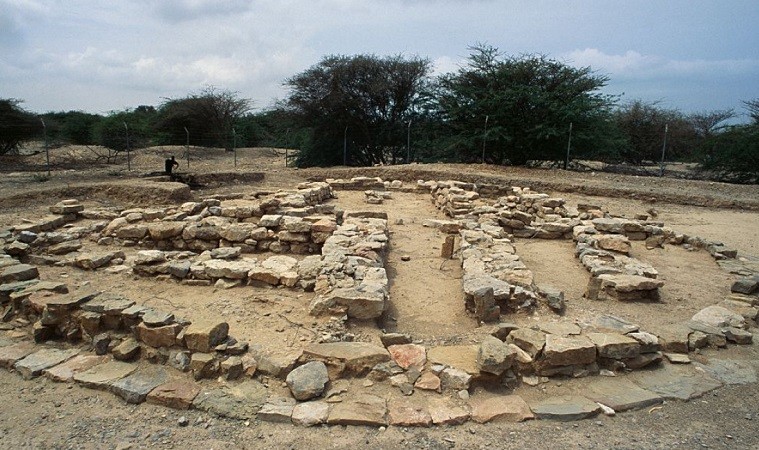
UAE: On an island off the coast of the United Arab Emirates, authorities have unearthed an old Christian monastery that may date back to the years when Islam spread throughout the Arabian Peninsula.
A new perspective on the history of early Christianity along the Persian Gulf coast can be gained from the monastery on Siniyah Island, which is a component of the sand dune sheikhdom of Umm al-Quwain. It is the second such monastery to be discovered in the Emirates, and it dates back as far as 1,400 years, long before the region's vast deserts gave rise to a thriving oil industry that resulted in the creation of a unified nation that is now home to the skyscraper-filled cities of Abu Dhabi and Dubai.
The two monasteries were lost in the sands of time as scholars assume that as Islam became more dominant in the area, Christians gradually converted to the Islamic faith. Even though Pope Francis arrived in the neighboring country of Bahrain on Thursday to encourage interreligious dialogue with Muslim leaders, Christians still make up a small percentage of the wider Middle East today.
The UAE is currently a "mixing pot of nations," according to Timothy Power, an associate professor of archaeology at the United Arab Emirates University who assisted in the investigation of the recently discovered monastery.
It is quite amazing that something comparable was happening in this location 1,000 years ago, and this is a tale that needs to be told, he added.
The monastery is located on Siniyah Island, which protects the Khor al-Beida marshlands in Umm al-Quwain, an emirate located along the Persian Gulf coast about 50 kilometres (31 miles) northeast of Dubai. The island features a string of sandbars jutting off it like crooked fingers, giving it the name "flashing lights," probably a result of the white-hot sun overhead. Archaeologists found the monastery on one in the northeastern corner of the island.
Samples from the monastery's founding that were carbon dated range in age from 534 to 656. Muhammad, the founder of Islam, was born about 570 and passed away in 632 after taking Mecca, which is now in Saudi Arabia.
The floor plan of the monastery on Siniyah Island shows that early Christians may have prayed inside a single-aisle church there. A baptismal font and an oven for making bread or wafers for communion rituals appear to be located in certain rooms. Also, an altar and a setup for communion wine were probably located in a nave.
There is a second structure next to the monastery that has four rooms and is probably built around a courtyard; this could have been the residence of an abbot or even a bishop in the early church.
Noura bint Mohammed al-Kaabi, the nation's minister of culture and youth, and Sheikh Majid bin Saud Al Mualla, the chairman of the Umm al-Quwain Tourism and Archaeology Department and the ruler of the emirate, both paid the site a visit on Thursday.
Even though much of the UAE has grown quickly, the island has remained a part of the holdings of the royal family, which has protected the area for years to allow for the preservation of historical sites.
The dig, which is still going on at the location, is partially financed by the UAE's Ministry of Culture. A group of structures that archaeologists think belonged to a pre-Islamic settlement are located only a few hundred metres (yards) from the church.
On some parts of the island, mountains of discarded clams from the pearling industry resemble enormous, industrial-sized hills. Another settlement nearby was destroyed by the British in 1820 before the area joined the Trucial States, the forerunner of the UAE. The collapse of that village resulted in the development of the mainland community of Umm al-Quwain today.
According to historians, early churches and monasteries were established all the way from the Persian Gulf beaches to the coasts of modern-day Oman and India. Other churches and monasteries akin to these have been discovered by archaeologists in Bahrain, Iraq, Iran, Kuwait, and Saudi Arabia.
On Sir Bani Yas Island, a natural preserve and location for opulent hotels off the coast of Abu Dhabi and close to the Saudi border, archaeologists found the first Christian monastery in the United Arab Emirates in the early 1990s. It also originates from the same time period as the recent discovery at Umm al-Quwain.
However, evidence of early life in Umm al-Khor Quwain's al-Beida marshlands dates back to the Neolithic era, indicating that the region has been continuously inhabited by people for at least 10,000 years, according to Power.
Today, the low-cost liquor store at the emirate's Barracuda Beach Resort is more well-known than the region close to the marsh. As it constructs a bridge to Siniyah Island for a $675 million real estate development, officials recently dismantled a huge, Soviet-era cargo jet tied to a Russian gunrunner known as the "Merchant of Death."
Power claimed that the discovery of the monastery was prompted by development. It is unknown what additional mysteries of the past may yet be concealed on the island beneath a thin layer of sand, but that site and others will be cordoned off and preserved, he said. Power described the discovery as "very exciting" because it represents "secret history" that isn't well-known.